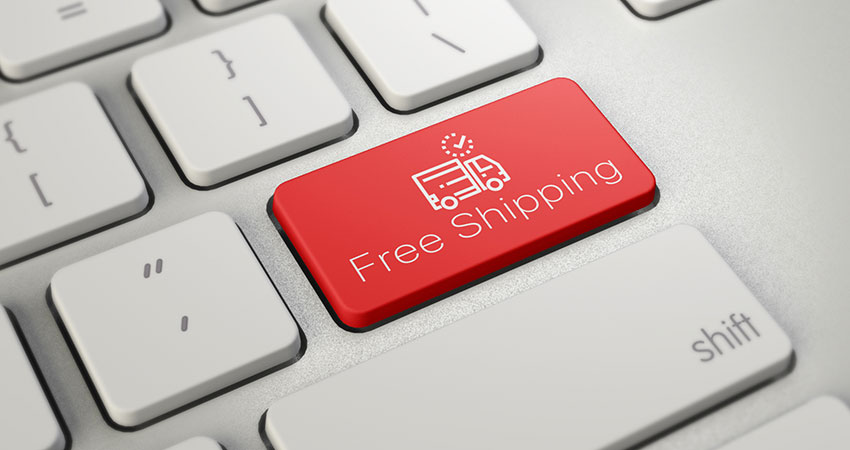There are many factors beyond product features and price that cause shoppers to hit the buy button. Shipping is a big part of that equation, but what kind of options are most likely to drive increased sales?
Given the Amazon Prime effect, many consumers now expect two-day shipping or less. Falling short of these expectations negative affect brand perception. According to a 2017 Dotcom Distribution Ecommerce Study of more than 600 online shoppers, one-third said faster shipping increases brand trust, while 90% said they value free shipping. Should you offer fast or free shipping? The answer can be complicated!
Despite their importance in ecommerce, these factors can hurt business margins. Offering both options may not always be feasible, especially for emerging brands. Successful implementation depends on balancing what customers value and your business goals.
Offering Faster Shipping Without Hurting Your Business
Statista Research found 26% of online shoppers cited slow shipping as the main reason behind cart abandonment in 2017, up 4% from 2016. Seventy-six percent of online shoppers surveyed in Dotcom Distribution’s 2018 Ecommerce study said delayed arrival of an online order would likely influence future purchase decision from that seller. It’s clear that failing to meet or exceed rising consumers expectations results in lost business.
While faster shipping methods are more expensive, you can control costs by providing options. For example, offer base shipping but allow customers to select another preferred method at their expense. Many shopping cart platforms enable setup of real-time shipping options and rates, sharing live shipping quotes based on items selected. This approach not only lets you cover the shipping costs or nearly so, but the level of control and transparency builds customer trust and loyalty.
Utilizing Transportation Management Systems (TMS) to rate shop helps you choose the most cost-effective methods. And an established fulfillment partner can leverage their carrier relationships to provide faster options at discounted rates, reducing costs and improving the customer experience.
Baking faster shipping into your price structure allows you to offer premium methods but keeps costs the same by adding a fraction of them onto the sale price.
Finally, communicate to customers upfront about the reasons for time in transit. If your kitting process involves pharmaceutical-level controls, or your packout process is designed to deliver a memorable unboxing experience, they’ll understand that extra care takes longer. Consider this an added opportunity for branding! Customers appreciate measures taken to improve their safety and experience, and the value of that may compensate for slower shipping. Think of it like a crème brûlée: you know it’s going to take longer than another dessert, but because it’s unique and special, the time and effort put into creating it will be well worth your while.
Lessening the Impact of Free Shipping
Free shipping plays a powerful role in generating a positive image and attracting customers. The 2017 UPS Pulse of the Online Shopper™ Study found that shipping fees were among the top factors people considered when purchasing items online. But waiving that fee without considering its financial impact on your business is unwise.
A common practice for waiving delivery fees is establishing an order threshold. This allows brands to use free shipping as a marketing tool while incentivizing extra spending. Determine a minimum amount that is favorable to customers while increasing the average order value enough to compensate for shipping costs.
A similar strategy involves asking shoppers to subscribe to a newsletter, follow social media pages, leave reviews or refer a friend in exchange for discounted shipping fees. Because these tasks are simple, shoppers may gladly oblige to save money, aiding your marketing efforts.
Membership programs can provide customers with exclusive benefits including free shipping. Generating consistent subscription fees can balance out delivery costs while incenting customers to purchase more to maximize the benefits. Loyalty programs also encourage additional purchasing in exchange for perks like free or discounted shipping.
Just as incorporating shipping into your price structure can enable faster shipping, it can also help you offer free shipping. In Dotcom Distribution’s 2017 and 2018 ecommerce studies, free shipping was the incentive most likely to result in future purchases. So, while higher prices are a turnoff, free shipping can make up for it.
Fast delivery and discounted or free shipping are two of the biggest factors that build customer trust and retention. The key to delivering the best experience while reaping the maximum benefit is finding the best fit for both your brand strategy and budget. Anything that drives more brand appeal is tempting, but beware of added expenses that hit the bottom line. Choose wisely.
Maria Haggerty is CEO of Dotcom Distribution

